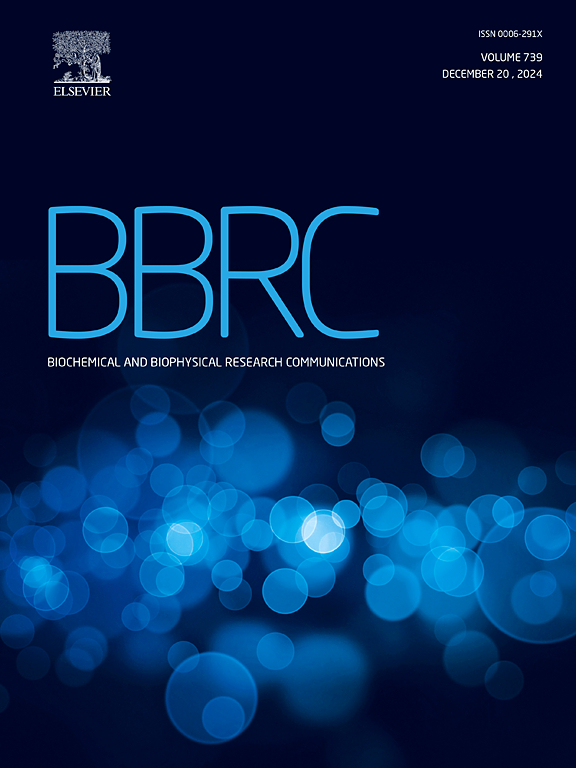线粒体功能障碍使 Ras 诱导的早期衰老成熟为完全衰老,并在鱼类细胞系 EPC 中形成与衰老相关的促炎分泌表型
IF 2.5
3区 生物学
Q3 BIOCHEMISTRY & MOLECULAR BIOLOGY
Biochemical and biophysical research communications
Pub Date : 2024-10-12
DOI:10.1016/j.bbrc.2024.150824
引用次数: 0
摘要
鱼细胞系与大多数哺乳动物二倍体细胞系不同,细胞衰老不容易被诱导。此前,我们曾证实,鱼类基因组中 p16 基因的缺失会阻止细胞达到完全衰老,即使 Ras 被激活也是如此。果蝇也缺乏 p16;然而,Ras 激活引发的早期衰老会发展到完全衰老,并伴随着线粒体缺乏导致的促炎性衰老相关分泌表型(SASP)。目前还不清楚线粒体缺乏是否也能诱导鱼类细胞系中由 Ras 诱导的早期衰老(RIS)成熟为完全衰老,并伴有促炎性 SASP。在此,我们研究了羰基氰化-3-氯苯腙(CCCP)诱导的线粒体功能障碍是否与活化的 Ras 共同导致完全衰老,以及在 EPC 鱼细胞系中是否伴有促炎性 SASPs。我们发现,虽然线粒体功能障碍的 EPC 细胞表现出促炎性 SASP,但这并不会导致细胞增殖永久停止或内源性 Ras 表达上调。这些发现表明,诱导完全衰老必须有其他因素与线粒体功能障碍共同作用。无论 CCCP 处理与否,过量表达构成性活性突变型 H-Ras(H-RasV12)的 EPC 细胞的增殖明显减少。这些发现表明,在鱼类和果蝇细胞中观察到的细胞衰老与缺乏 p16 基因的细胞衰老有相似之处。但需要注意的是,鱼类细胞与果蝇细胞不同,仅线粒体功能障碍就能诱导促炎 SASP 因子。本文章由计算机程序翻译,如有差异,请以英文原文为准。
Mitochondrial dysfunction matures Ras-induced early senescence to full senescence with a proinflammatory senescence-associated secretory phenotype in the fish cell line, EPC
Fish cell lines differ from most mammalian diploid cell lines by the fact that cellular senescence is not readily induced. Previously, we demonstrated that the absence of the p16 gene in the fish genome prevents cells from reaching full senescence even when Ras is activated. Drosophila also lacks p16; however, early senescence triggered by Ras activation progresses to full senescence and is accompanied by a proinflammatory senescence-associated secretory phenotype (SASP), due to mitochondrial deficiency. It is unclear whether mitochondrial deficiency can also induce the maturation of Ras-induced early senescence (RIS) to full senescence along with a proinflammatory SASP in fish cell lines. Here, we investigated whether mitochondrial dysfunction induced by carbonyl cyanide 3-chlorophenylhydrazone (CCCP) in concert with activated Ras results in full senescence and whether this is accompanied by a proinflammatory SASPs in the EPC fish cell line. We found that although EPC cells with mitochondrial dysfunction exhibited a proinflammatory SASP, this did not result in permanent cell proliferation arrest or the upregulation of endogenous Ras expression. These findings suggest that other factors must act in concert with mitochondrial dysfunction to induce full senescence. The proliferation of EPC cells overexpressing a constitutively active mutant of H-Ras (H-RasV12) was markedly reduced, irrespective of CCCP treatment. These findings suggest that there are similarities between the cellular senescence observed in fish and Drosophila cells lacking the p16 gene. However, it should be noted that fish cells differ from Drosophila cells in that mitochondrial dysfunction alone can induce proinflammatory SASP factors.
求助全文
通过发布文献求助,成功后即可免费获取论文全文。
去求助
来源期刊
CiteScore
6.10
自引率
0.00%
发文量
1400
审稿时长
14 days
期刊介绍:
Biochemical and Biophysical Research Communications is the premier international journal devoted to the very rapid dissemination of timely and significant experimental results in diverse fields of biological research. The development of the "Breakthroughs and Views" section brings the minireview format to the journal, and issues often contain collections of special interest manuscripts. BBRC is published weekly (52 issues/year).Research Areas now include: Biochemistry; biophysics; cell biology; developmental biology; immunology
; molecular biology; neurobiology; plant biology and proteomics

 求助内容:
求助内容: 应助结果提醒方式:
应助结果提醒方式:


